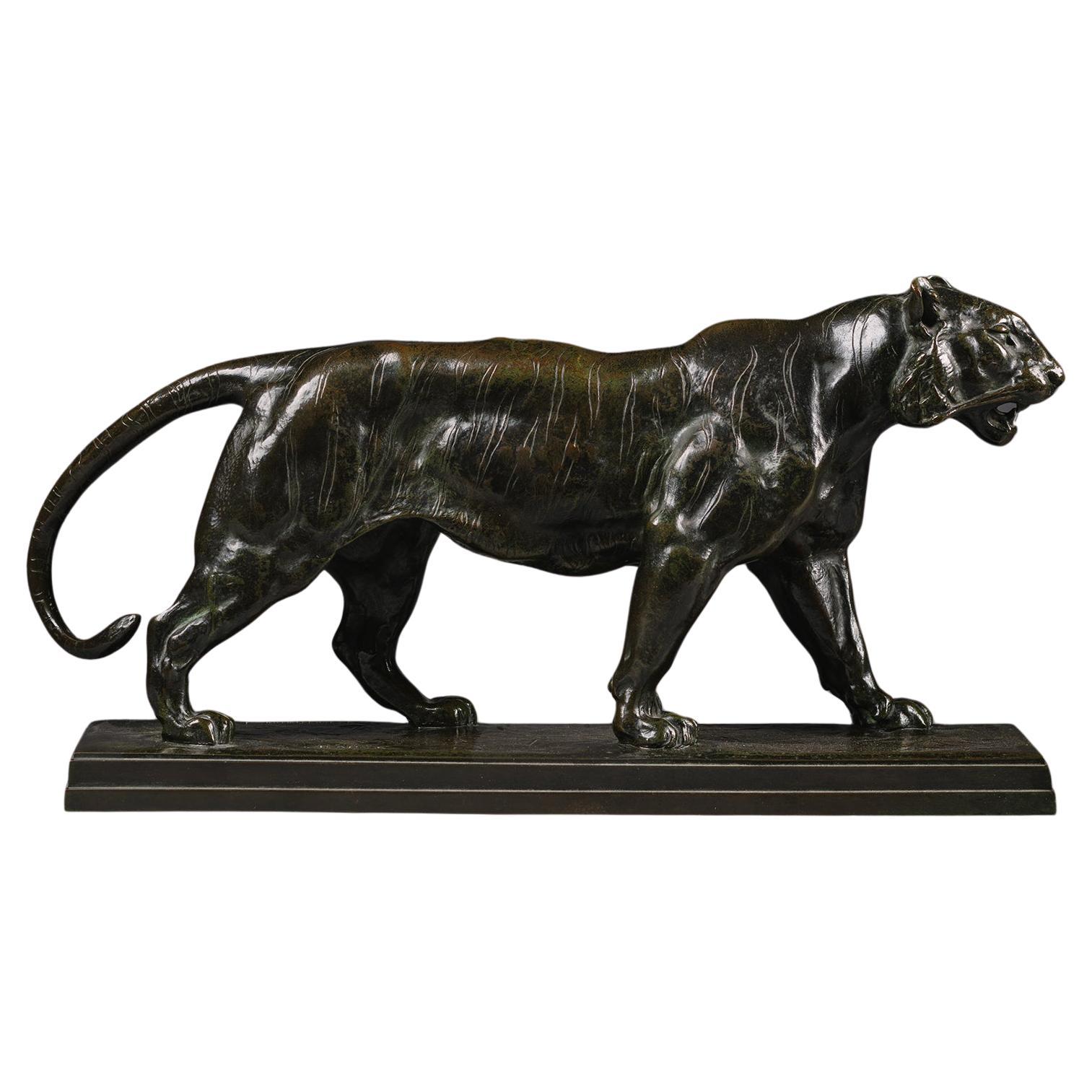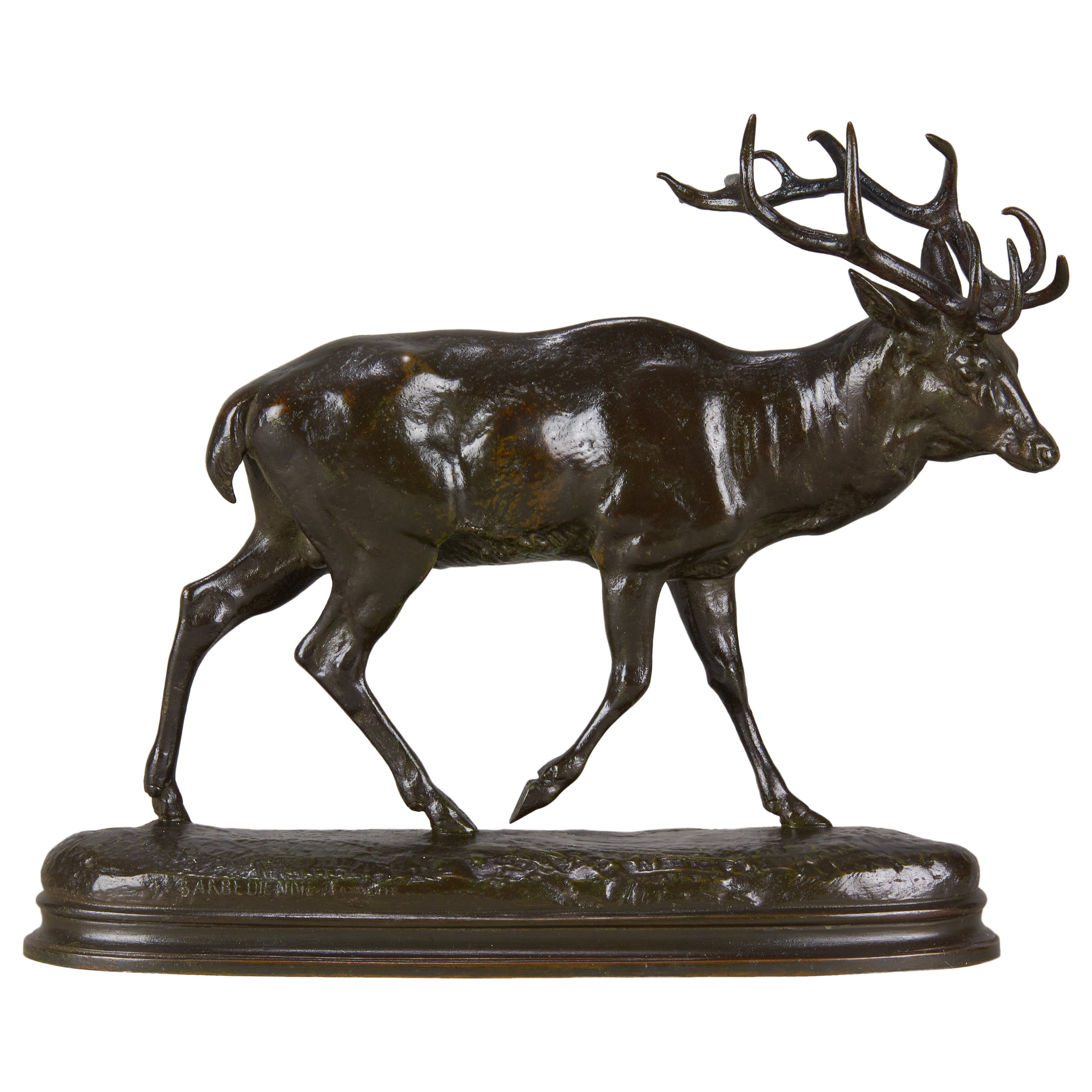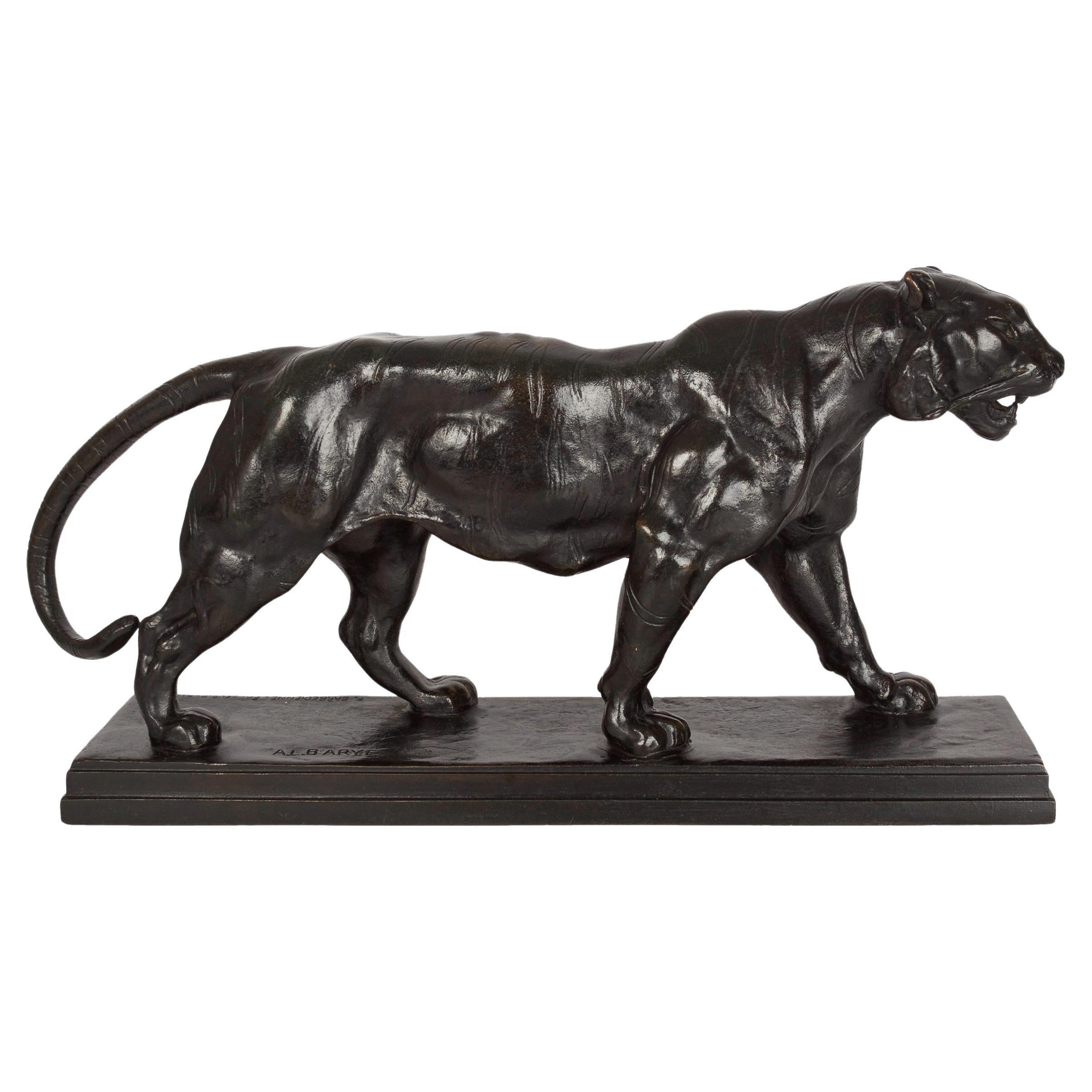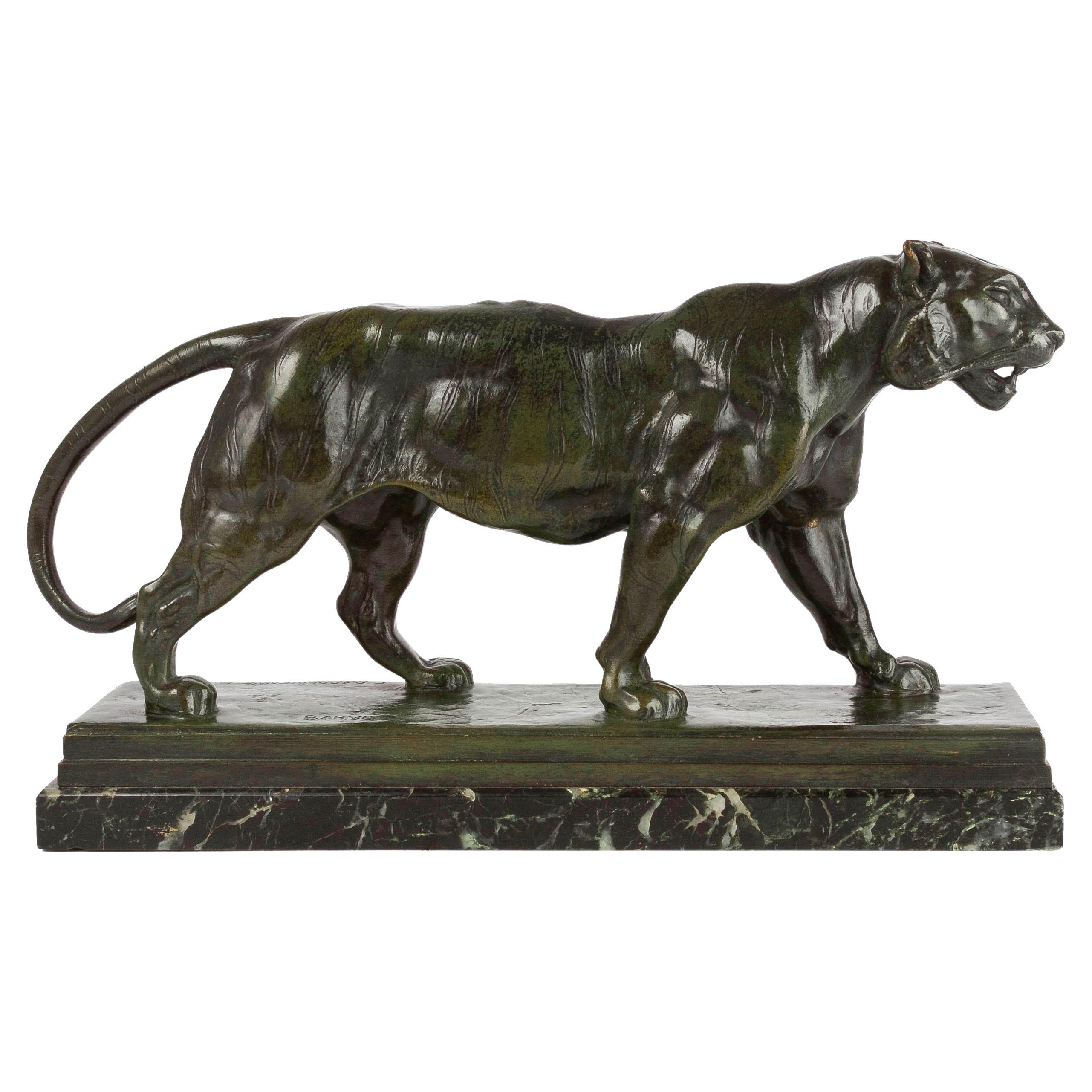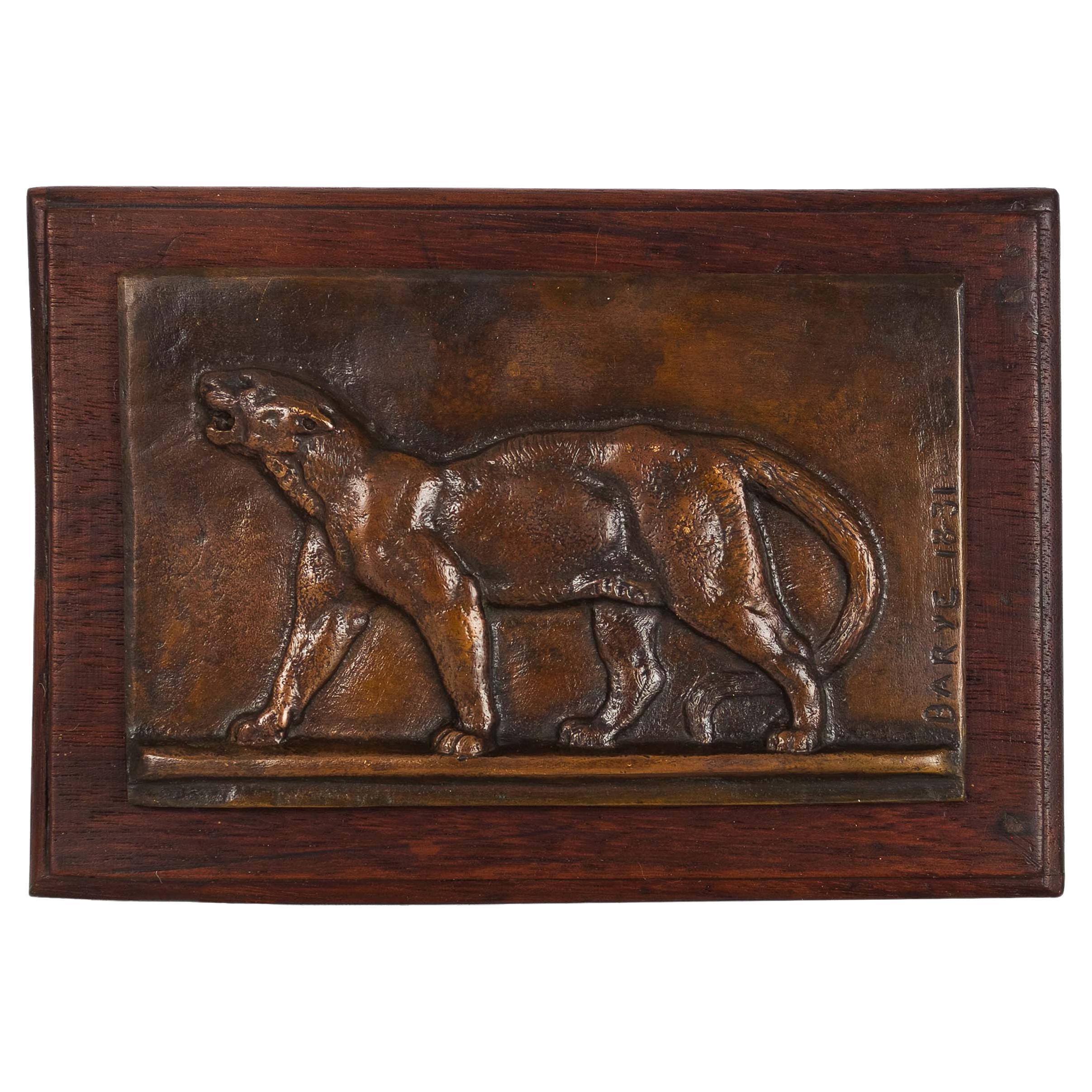Jaguar Qui Marche No. 2 (Walking Jaguar) Antoine L Barye
About the Item
- Creator:Antoine-Louis Barye (Maker)
- Dimensions:Height: 4.33 in (11 cm)Width: 2.76 in (7.02 cm)Depth: 8.66 in (22 cm)
- Style:Louis Philippe (Of the Period)
- Materials and Techniques:Bronze,Cast
- Place of Origin:
- Period:
- Date of Manufacture:Circa 1840
- Condition:Wear consistent with age and use.
- Seller Location:Newark, GB
- Reference Number:
Antoine-Louis Barye
The son of a goldsmith, Parisian born Antoine-Louis Barye was a sculptor of animal subjects and acclaimed, not only for his apparent skill but as the founder of what became known as the French Animaliers School. Among his patrons were representatives of the state government and royalty, including the Duke of Orleans and the Dukes of Luynes, Montpensier and Nemours.
Well compensated financially, Barye was able to buy the best of materials and hire the country's most skilled foundry craftsmen. The foundry he hired was owned by Ferdinand Barbedienne and casts from this period were stamped with the letters, FB. However, he did not make a lot of money from his work because he was such a perfectionist that often he would not sell his work because he thought it was not "quite right." In 1848, he declared bankruptcy and his molds and plaster casts were sold along with the copyrights.
Barye's specialty was aroused, angry-seeming wild game such as lions and tigers and elephants, but he also did equestrian groups and mythology figures. In order to do realistic depictions of animal anatomy, he spent much time at the Jardin des Plantes in Paris. His early training was as an apprentice to a metal engraver, but being drafted in the army in 1812 ended that education. In 1832, he had established his studio, and unique at that time was his method of cold stamping his bronze casts so that each one had a special number. He had his first entry, The Milo of Croton, in the Paris Salon in 1819, winning a second prize. In 1831, a work regarded as a masterpiece, Tiger Devouring a Gavial, was in the Salon and purchased for the Luxembourg Gardens, which is now in the Louvre. However, many of his subsequent Salon submissions were rejected and so angered him that between 1836 and 1851, he refused to submit entries. In 1851, he again exhibited at the Salon with Jaguar Devouring A Hare, and this work, like the 1831 entry, was placed in the Luxembourg Gardens and eventually in the Louvre.
In spite of problems with the Salon, Barye received many accolades for his work, and the period of 1837–48 was considered the most productive time of his career. However, in 1848, when he lost control of his work and it was reproduced by others including Martin and Barbedienne, the sculptures, according to some art professionals, are not as skillfully executed. In 1848, after his bankruptcy, Barye became director of Casts and Models in the Louvre, until 1850, when he was replaced by Emmanuel Fremiet. It was a very difficult time for him. However, within a few years, he began receiving accolades for the quality and uniqueness of his work, and people began appreciating the powerful images of his sculpture, especially the wildlife in their natural surroundings. In 1854, he was appointed Master of Zoological Drawing in the Musée National d'Histoire Naturelle and held this position until his death in 1875.
- ShippingRetrieving quote...Ships From: Newark, United Kingdom
- Return PolicyA return for this item may be initiated within 14 days of delivery.
- White Onyx Polar Bear by Alfred Lyndhurst Pocock (Faberge Sculptor 1905-1915)By Alfred Lyndhurst PocockLocated in Newark, EnglandOnyx Polar Bear on a Rock Crystal Iceberg From our Sculpture collection, we are thrilled to offer this White Onyx Polar Bear by Alfred Lyndhurst Pocock. The Polar bear beautifully carved with a naturalistic look finished with cabochon ruby eyes stood upon a natural rock crystal base simulating an iceberg. The Polar Bear was carved by the Faberge sculptor Alfred Lyndhurst Pocock (1882-1962) during the first half of the 20th century circa 1920. Provenance this sculpture was owned by the family of Percy and Winifred Bottley. The Bottleys ran the gem dealership Gregory & Bottley from the 1930s (later Gregory, Bottley & Lloyd), and worked with Pocock supplying him with gemstones for his carvings. When Pocock died...Category
Early 20th Century English Animal Sculptures
MaterialsMulti-gemstone, Onyx, Rock Crystal
- Japanese Meiji Period Carved Wood Okimono Man with RabbitsLocated in Newark, EnglandThe charming figure, carved from a single piece of wood is exceptionally carved showing the male figure with humorous expression holding two Rabbits one by the ears and the second under his arm. A third Rabbit stands at the feet of the male looking up, each rabbit with a different expression. The male figure is wearing traditional Japanese attire with his hair tied back stood upon a naturalistic base. The figure dates to the Meiji Period (1868-1912) circa 1900. Notes The Rabbit is one of the 12 animals to feature in the Japanese Zodiac signs which follows the Chinese astrological system along with the Rat, Ox, Tiger, Rabbit, Dragon, Snake, Horse, Goat, Monkey, Rooster, Dog, Pig. Such division is connected with the Jupiter cycle around the Sun, which lasts about 12 years. As 2023 is the year of the Rabbit...Category
Antique Early 1900s Japanese Meiji Sculptures and Carvings
MaterialsWood
- Swiss Black Forest Dog Group Walter Mader (attributed)By Walter MäderLocated in Newark, EnglandFeaturing a Dog with Pups Rare Swiss Black Forest Dog group. The group modelled as a smooth coat St. Bernard female with her three puppies. The...Category
Antique Early 1900s Swiss Black Forest Animal Sculptures
MaterialsWood
- Japanese Meiji Period Bronze Group Bear & Alligator by YoshimitsuLocated in Newark, EnglandThe Japanese group comprises of a Bear being attacked by a large alligator. The alligator jumping on the back of the Bear with mouth wide opening showing its razor sharp teeth. The b...Category
Antique Late 19th Century Japanese Meiji Animal Sculptures
MaterialsBronze
- Greek Grand Tour Bronze Giorgio SommerBy Giorgio SommerLocated in Newark, EnglandFine 19th century grand tour patinated bronze figure of a seated greek mythological male. The man full of expression with noticeable hand gestures glaring at the ground. The figure p...Category
Antique Late 19th Century Italian Classical Greek Figurative Sculptures
MaterialsBronze
- Italian Carrara Marble Bust Augustus CaesarLocated in Newark, EnglandThe bust intricately carved from Italian Carrara marble with lifelike features including textured hair and shaped chest. The bust carved as Gaius Julius Caesar Augustus Octavius (lat...Category
Antique Early 18th Century Italian Renaissance Busts
MaterialsCarrara Marble
- Antoine-Louis Barye (French, 1795-1875) 'Tigre qui Marche'By Antoine-Louis BaryeLocated in Brighton, West SussexAntoine-Louis Barye (French, 1795-1875) 'Tigre qui Marche' Bronze with dark brown patina. Signed 'BARYE' and with the foundry mark 'F. BARBEDIENNE. Fondeur' on the base. France, C...Category
Antique 19th Century French Animal Sculptures
MaterialsBronze
- "Cerf Qui Marche" by A L BaryeBy Antoine-Louis BaryeLocated in London, GBExcellent late 19th Century French bronze figure of a walking stag with beautiful autumnal, green. black. brown and orange patination and excellent hand finished surface detail on an oval naturalistic base with integral stepped plinth, signed Barye and inscribed F Barbedienne Fondeur ADDITIONAL INFORMATION Measures: Height: 19 cm Width: 22 cm Condition: Excellent Original Condition Circa: 1870 Foundry: F Barbedienne Materials: Bronze Book Ref Barye by Michel Poletti & Alain Richarme ABOUT Antoine Louis Barye “The Michelangelo of the Menagerie” These are the words of Théophile Gautier in praise of Barye’s genius. Throughout his life Barye endeavoured to capture the fundamental nature of the animal kingdom in all its diversity, wild or tame, exotic or familiar, cruel or gentle, bringing to life the roaring, trembling, living beasts. The son of a goldsmith, apprenticed to a steel engraver at a young age, Barye found himself making moulds for ornaments, acquiring knowledge that he would later build on to produce his exquisitely chased bronzes. When he was called up at seventeen, he joined the army’s topographic brigade where he used clay to model raised relief maps...Category
Antique Mid-19th Century French Art Nouveau Animal Sculptures
MaterialsBronze
- After Antoine-Louis Barye Walking Lion Le lion qui marche White Marble EffectLocated in BUNGAY, SUFFOLKAntiquarian Marble -Effect, Walking White Lion The white lion, roaring and striding forwards. On a plinth decorated with greek key ornament. White marble effect resin. After the ant...Category
Vintage 1960s English Baroque Animal Sculptures
MaterialsResin
- French Bronze Sculpture "Tiger Walking" after Antoine-Louis Barye, BarbedienneBy F. Barbedienne Foundry, Antoine-Louis BaryeLocated in Shippensburg, PAANTOINE-LOUIS BARYE French, 1795-1875 "Tigre Qui Marche" Dark brown patinated bronze Signed in base "A.L. BARYE", incised "F. BARBEDIENNE FONDEUR, PARIS", cold-stamped FRANCE cold-tooled to underside 19.691 conceived 1841, cast circa early 20th century Item # 111GPP20Q Barye's ability to merge our romantic idealization of nature with a colder reality of nature's predator is beautifully represented in this striding cat. Originally conceived in 1841, Tigre Qui Marche (Walking Tiger...Category
Early 20th Century French Romantic Animal Sculptures
MaterialsBronze
- French Antique Bronze Sculpture"Walking Tiger"by Antoine-Louis Barye, BarbediennBy F. Barbedienne Foundry, Antoine-Louis BaryeLocated in Shippensburg, PAANTOINE-LOUIS BARYE French, 1795-1875 "Tigre Qui Marche" Patinated bronze Signed in base "BARYE", incised "F. BARBEDIENNE FONDEUR, FRANCE" conceived 1841, cast circa 1880-1900 Item # 110UGP10Q Barye's ability to merge our romantic idealization of nature with a colder reality of nature's predator is beautifully represented in this striding cat. Originally conceived in 1841, Tigre Qui Marche (Walking Tiger...Category
Antique 19th Century French Romantic Animal Sculptures
MaterialsMarble, Bronze
- French Bronze Sculpture Bas-Relief "Walking Leopard" after Antoine-Louis BaryeBy Antoine-Louis BaryeLocated in Shippensburg, PAANTOINE-LOUIS BARYE (AFTER) France, 1796-1875 "WALKING LEOPARD" (conceived 1831, cast circa 1890-1910) Patinated bronze bas-relief plaque on walnut panel Signed "BARYE 1831" Item # 110CFX23P A beautifully textured and well-preserved bas-relief plaque after Antoine-Louis Barye's Walking Leopard mounted...Category
Antique 19th Century French Romantic Animal Sculptures
MaterialsBronze
